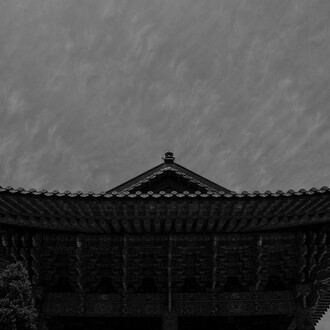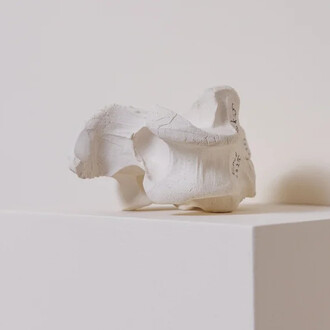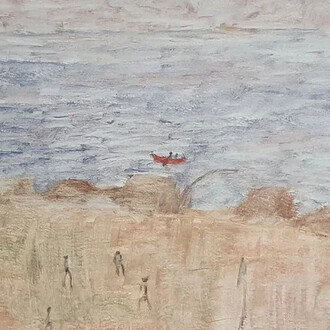Throughout her six-decade career, the American artist Sylvia Snowden has developed a distinctive visual lexicon, one in which paint is capable of embodying the complexity and vulnerability of the human condition. Making use of a bold, figurative technique – what the artist has referred to as a form of ‘structural abstract expressionism’ – Snowden’s paintings are produced by building churning layers of thick acrylic paint and oil pastel on paper, canvas (and later Masonite), her use of colour grounded in a base palette of void-like whites and earth tones. Misshapen and distorted, the figures in Snowden’s works operate at the edges of comprehension. Verging on abstraction, they transcend the boundaries of representation to become empathetic ‘portraits of the unquantifiable fervour of human emotion’.1
On the verge brings together several paintings from across Snowden’s career, including several pieces from her seminal M street series (1978–97), itself an essential contribution to the canon of late-20th-century American painting. Named after a street in Shaw, Washington, DC, the neighbourhood where Snowden has lived and worked since 1978, the M street paintings were created against a backdrop of political and socioeconomic turbulence in the United States, the effects of which were felt deeply by society’s most vulnerable communities. Characterised by high rates of inflation and unemployment, this period was also marked by ongoing racial tensions in America’s post-civil rights era. While her use of textured, sculptural impasto and Masonite materially embodies physical and psychological hardships, Snowden’s paintings steadfastly resist caricature. Avoiding explicit social commentary or resource to any clear markers of identification, Snowden notes, ‘The subject matter of my painting is the human being, period.’2
Snowden eschews any formal, representational approach to portraiture to instead unearth the psychological conditions of the personalities. The rugged surface of Francine (c.1978) fuses abstraction and figuration as a testimonial device, recalling the intense emotional depth held within the distorted figures of Jean-Michel Basquiat. Snowden’s bodies are elongated; pulled towards the edges of the frame, their twisted limbs uncomfortably hyperex- tended, at times seeming to writhe with pain. Each painting in the M street series depicts – and is named after – a member of the Shaw community. In Steven Thornhill (1979) and Theresa Black (1997) Snowden confronts the viewer with supine figures, the dimensions of the Masonite recalling a casket or an unfilled grave. The funereal quality of the compositions gesture, perhaps, to the many public processions and open-casket funerals that took place during the Civil Rights movement as expressions of collective grief and political protest. The heaviness of Snowden’s impasto forces her to work initially with paintings on the floor, as though her figures are weighed down by their own materiality, unable to stand upright. Yet, Snowden’s use of bright, chameleonic colour and gestural brushwork lends her figures a sense of muscularity and movement; they ripple with life, as though capable of breaking the boundaries of their pictorial plane. This seems true, especially, of the dynamic figure in Untitled (Purple hand) (2002), whose looming, claw-like hands stretch forwards. ‘They’re coming out to meet you, to greet you,’ Snowden has remarked, ‘the point is, they’re pushing out of those parameters’.3 In this sense, the bodies occupying Snowden’s paintings may be read as relatives of Michelangelo’s unfinished sculptures that feature figures partially entombed within their marble blocks, and which scholars refer to as ‘Prisoners’ or ‘Slaves’ for their depiction of the eternal human struggle for freedom.
Born in 1942 in Raleigh, North Carolina, Snowden moved to Washington, DC as a teenager in 1956, later enrolling at Howard University, where she studied under prominent Black artists including Lois Mailou Jones, James Amos Porter, James Lesesne Wells, and David Driskell. Porter was also responsible for Sylvia’s time studying at the Skowhegan School of Painting and Sculpture. In 1962, Snowden took a trip to Paris, led by Lois Mailou Jones, during which time she also studied at Académie de la Grande Chaumière. Embedded within a lineage of 20th century expressionism, Snowden’s painterly vocabulary dialogues with the likes of Oskar Kokoschka, Chaïm Soutine and Ernst Ludwig Kirchner. The relationship with Soutine’s work is detectable, for example, in the undulating brushwork and exaggerated physical features of Snowden’s Betty (1974), an early painting in which Snowden comments on the nature of relationships between white women and Black men in America, her figures distorted in a carnivalesque, erotic scene, at once alluring and grotesque.
Like so many of Snowden’s paintings, Ethel Moyd (1984) is rife with contradictions. Equally wrathful and compassionate in tone, the painting communicates both entrapment and a sense of liberation, whilst its palette of reds and blues reflects the coexistence of opposing elemental forces of fire and water. Rendered in swirls of molten acrylic and accretions of dense oil, the human forms depicted in Snowden’s paintings are sinewy and energetic, straining and strained, vibrating, it seems, with a will of their own. Materially potent and emotionally sophisticated, On the verge is a testament to human endurance; to life persisting in the face of hardship and adversity, and equally, a means of granting visibility to overlooked and marginalised communities. Snowden’s paintings, though exemplary of 20th century expressionist sensibilities, speak to the individual struggle in a manner that is, at the same time, profoundly universal. ‘Because we’re human beings, we all have the same sort of tugs and pushes through life,’ she has said, ‘and that’s what I’m painting about.’4
Notes
1 Charlotte Jansen, ‘The Peak of Snowden’, The world of interiors, 4 September 2023.
2 Sylvia Snowden in conversation with Hans Ulrich Obrist, Heroine, Issue 22, Spring 2025, p.201.
3 ‘Sylvia Snowden by Joe Bradley’, Bomb, 2 October 2023.
4 Sylvia Snowden interview with Elizabeth Fullerton, ‘Expressionist painter Sylvia Snowden: ‘White people will show some Black art …then it wears off’, The guardian, 22 September 2023.
















